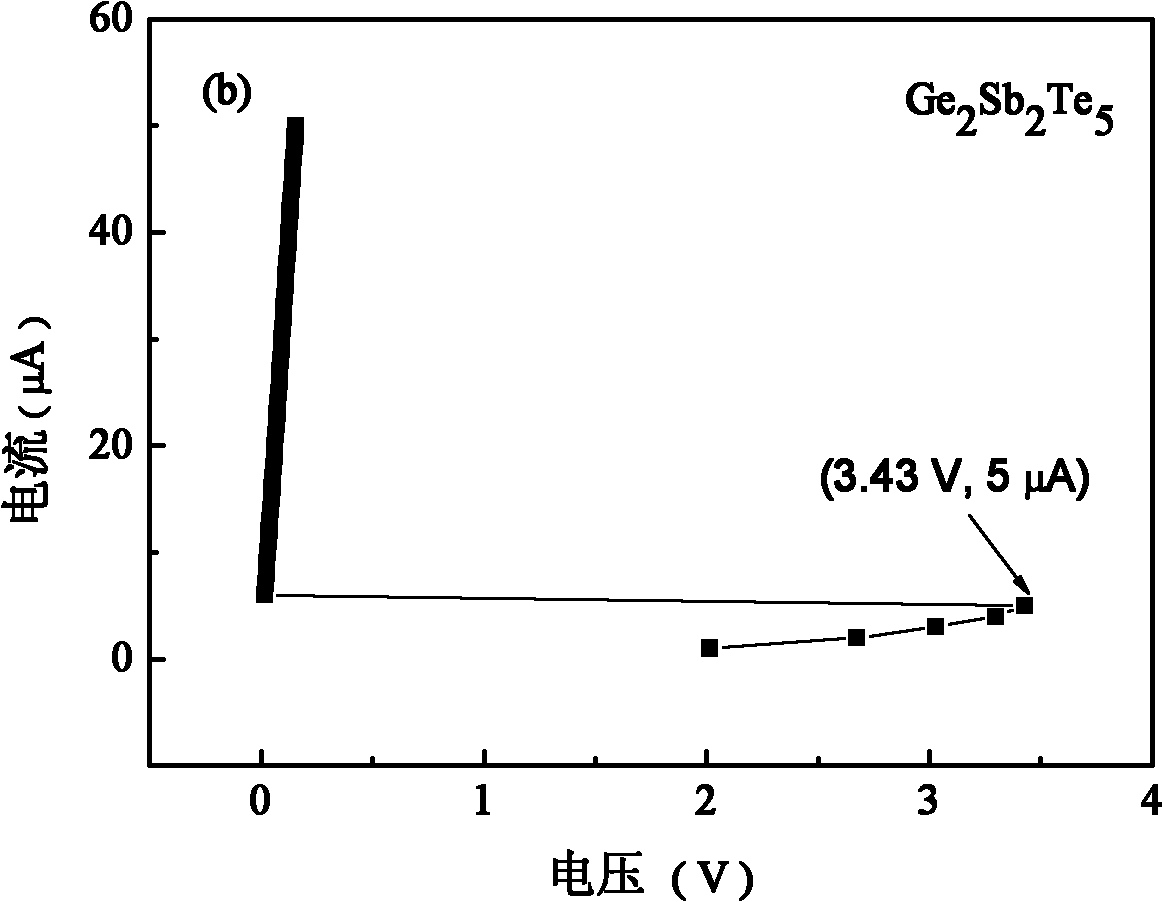Nanometer composite multilayer phase change thin-film material for phase change memory
A phase-change memory and nanocomposite technology, which is applied in the field of nanocomposite multilayer phase-change thin film materials, can solve the problems of poor thermal stability and high power consumption of device unit operations, and achieve high crystallization temperature, good amorphous thermal stability, The effect of good thermal stability
- Summary
- Abstract
- Description
- Claims
- Application Information
AI Technical Summary
Problems solved by technology
Method used
Image
Examples
Embodiment 1
[0041] Prepare GeTe / Ge with the following structure 2 Sb 2 Te 5 Nanocomposite multilayer phase change film material, the structure of the film material is specifically [GeTe(5nm) / Ge 2 Sb 2 Te 5 (5nm)] 10 and [GeTe(7nm) / Ge 2 Sb 2 Te 5 (5nm)] 8 , and the GeTe / Ge 2 Sb 2 Te 5 The total thickness of the nanocomposite multilayer phase change film material is 100nm.
[0042] Concrete preparation steps are as follows:
[0043] 1) Clean SiO2 2 / Si(100) substrate: clean the surface and back, remove dust particles, organic and inorganic impurities; strong ultrasonic cleaning in acetone solution for 3-5 minutes, rinse with deionized water; then strong ultrasonic cleaning in ethanol solution for 3-5 minutes, rinse with deionized water, high-purity N 2 Dry the surface and back; dry the water vapor in an oven at 120°C for about 20 minutes;
[0044] 2) Install the sputtering target: set the radio frequency power, set the sputtering gas flow rate and sputtering pressure;
[00...
Embodiment 2
[0067] The prepared structures are [GeTe(15nm) / Ge 2 Sb 2 Te 5 (5nm)] 5 、[GeTe(5nm) / Ge 2 Sb 2 Te 5 (1nm)] 17 、[GeTe(1nm) / Ge 2 Sb 2 Te 5 (15nm)] 6 and [GeTe(1nm) / Ge 2 Sb 2 Te 5 (5nm)] 17 GeTe / Ge 2 Sb 2 Te 5 Nanocomposite multilayer phase change thin film material, and the GeTe / Ge 2 Sb 2 Te 5 The total thickness of the nanocomposite multilayer phase change thin film material is 100nm, 102nm, 96nm and 102nm respectively.
[0068] Concrete preparation steps are as follows:
[0069] 1) Clean SiO2 2 / Si(100) substrate: clean the surface and back, remove dust particles, organic and inorganic impurities; strong ultrasonic cleaning in acetone solution for 3-5 minutes, rinse with deionized water; then strong ultrasonic cleaning in ethanol solution for 3-5 minutes, rinse with deionized water, high-purity N 2 Dry the surface and back; dry the water vapor in an oven at 120°C for about 20 minutes;
[0070] 2) Install the sputtering target: set the radio frequency powe...
Embodiment 3
[0077] The prepared structure is [GeTe(5nm) / Ge 2 Sb 2 Te 5 (5nm)] 10 GeTe / Ge 2 Sb 2 Te 5 Nanocomposite multilayer phase change thin film material, and the GeTe / Ge 2 Sb 2 Te 5 The total thickness of the nanocomposite multilayer phase change film material is 100nm.
[0078] Concrete preparation steps are as follows:
[0079] 1) Clean SiO2 2 / Si(100) substrate: clean the surface and back, remove dust particles, organic and inorganic impurities; strong ultrasonic cleaning in acetone solution for 3-5 minutes, rinse with deionized water; then strong ultrasonic cleaning in ethanol solution for 3-5 minutes, rinse with deionized water, high-purity N 2 Dry the surface and back; dry the water vapor in an oven at 120°C for about 20 minutes;
[0080] 2) Install the sputtering target: set the radio frequency power, set the sputtering gas flow rate and sputtering pressure;
[0081] Preparation of GeTe / Ge by Magnetron Alternating Sputtering at Room Temperature 2 Sb 2 Te 5 Nano...
PUM
| Property | Measurement | Unit |
|---|---|---|
| Thickness | aaaaa | aaaaa |
| Thickness | aaaaa | aaaaa |
Abstract
Description
Claims
Application Information
 Login to View More
Login to View More - R&D
- Intellectual Property
- Life Sciences
- Materials
- Tech Scout
- Unparalleled Data Quality
- Higher Quality Content
- 60% Fewer Hallucinations
Browse by: Latest US Patents, China's latest patents, Technical Efficacy Thesaurus, Application Domain, Technology Topic, Popular Technical Reports.
© 2025 PatSnap. All rights reserved.Legal|Privacy policy|Modern Slavery Act Transparency Statement|Sitemap|About US| Contact US: help@patsnap.com



